Remote Flat Point Station on the North Island‘s rugged Wairarapa coast has been home to the McGuinness family for just over four decades. It‘s a special place. The hills are alive with sheep and cattle, crops wave in the wind, and millions of stars adorn the night sky. But if you‘re into trucks, other stars may also attract your attention.
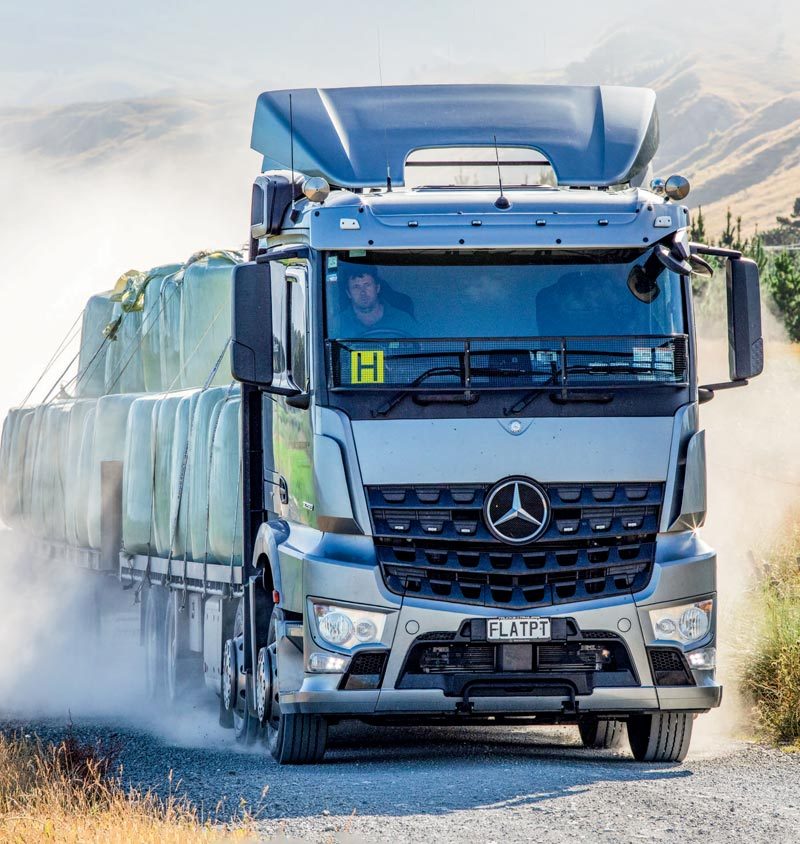
Worldwide, Mercedes- Benz truck and bus plants churn out truck after truck. Each one inches through the factory assembly lines, coming together piece by piece, oblivious to where it will end up, and who it will serve. Some will be worker bees, a GL code in the ledger of an enormous logistic giant. But now and then one truck‘s destiny will be something more, and it will carry far more than solely the payload on its back. Its working life will be woven into that of the family who signs the sales and purchase agreement. It will play a vital part in building a legacy. And to cap it off, it will go to a place precious few of its forbearers ever called home – a place like Flat Point Station. There‘s a further cherry on the cake when it comes to the latest three-pointed star to arrive at Flat Point. The 3258 Arocs that drove through the gate in the middle of last year is the farm‘s first brand-new Mercedes-Benz, taking its place alongside an existing 2009 ex-Bushetts Transport 3254 Actros. “We weren‘t necessarily thinking new at the outset, but there was just nothing around in the reasonably late-model under-half-millionkilometre bracket,” says Jay McGuinness. “They‘d all done a million kilometresplus. That‘s when John O‘Sullivan at Trucks and Trailers suggested we look at a new one they had in stock. It had been in the country since 2018. We crunched the numbers, and it all looked good. So, yep, we took it.”
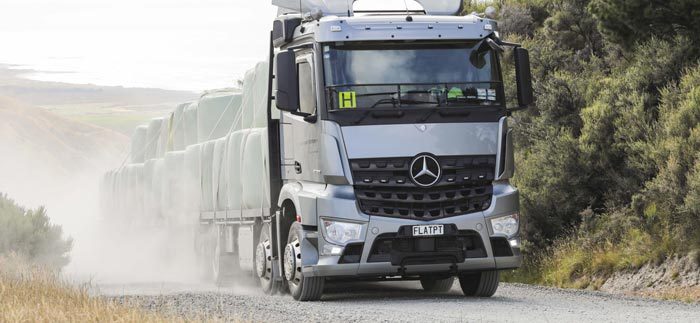
Photo: Almost at the top of the hill with the station visible way below in the background.
Sunrise at Flat Point
Flat Point Station is a 3000-hectare sheep, beef, and cropping station 50 minutes east of Masterton on the Wairarapa coast and it‘s home to the McGuinnesses. There‘s Jay and Bev McGuinness and their four children Alice (13), Sam (12), Brodie (10), and Fergus (8). About half a kilometre up the road are Jay‘s parents, John and Mary, who purchased the property in 1980. While still very much a part of station life, they‘ve also developed a small lifestyle subdivision on the station, and run luxury chalets for those wanting to shed themselves of life‘s burdens for a spell. Jay has two brothers, Ben, a neuro-radiologist, and Charles, who has a house on the farm and operates machinery as well as driving the farm‘s 4×2 Renault Premium tip truck. In terms of staff, there‘s livestock manager/sharefarmer John Hitchcock, shepherd Alex McGregor, machine operator/truck driver John Marr, and truck driver Brent Plaisted who was off at the time of writing with a badly misbehaving knee.

Photo: The Arocs on Flat Point Station road.
Before moving to Flat Point, John and Mary had a farming and agricultural contracting business in Te Awamutu in the Waikato. John was 34 back then with a young family, and life was frantic, to say the least. “Dad was just never home,” says Jay. “He was working himself ragged. Then one day, he went to look at this station in the Wairarapa that was for sale. I was only six at the time. Long story short, they bought it and we uppedsticks and moved down. Flat Point allowed him to run his business with his family, rather than away from them.” In painting the early picture, there are many clues that tell you about the personalities and life on the farm today. “The Te Awamutu days are where I get my love of tractors and trucks from. I was hooked from the start,” says Jay, backed 100% by wife Bev. “Jay is a farmer obsessed with machinery,” says Bev succinctly. What we find out later, however, is that although a science teacher by trade, Bev‘s a Gisborne lass raised in the remote Hungaroa River Valley and her grandfather was an arial topdressing pioneer. Suffice to say, remote farm life and mechanical marvels are in her blood also, so little wonder Brodie and Fergus in particular already have diesel pouring from their tear ducts! Back to Jay.

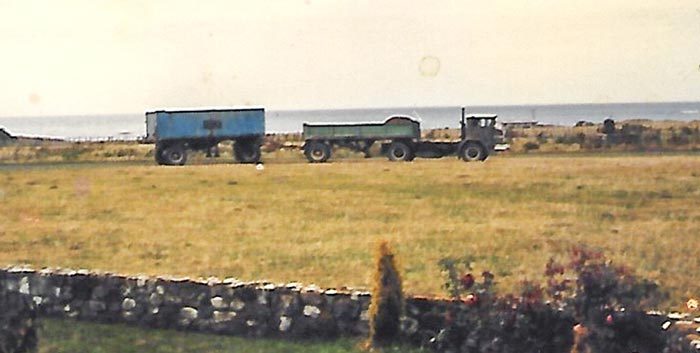

Photos: (Top/Middle) The ‘butter box‘ Acco loaded with wool and in A-train trim on Flat Point. (Bottom) The ex-Warren Fowler 2632 was big gear when it turned up.
“Dad ran machinery and trucks. There was an S Bedford early on, and then he had an International Acco ‘Butterbox‘. It was 180hp and had two semis with hydraulic landing legs. He‘d load them separately and then hook up a dolly to make an A-train. He used to go to Napier in that thing. I remember sitting on the engine tunnel to keep warm. Tractors and trucks – they‘re my passion really.” Once at Flat Point, John worked the only way he knew how – tirelessly – growing both the farming and contracting businesses. Not long after the move, the Acco made way for a 240hp Isuzu 4×2 tractor unit. In time Jay began to earn his stripes, and at age 17, he sat and passed his heavy truck and trailer licence under the old dispensation system. “The day after I got my licence, I was in the Isuzu with a single semi heading for Wellington with a load of wheat,” he says, with a laugh. “That‘s the deep end.”
A star is born
Besides the contracting, the station looked after the bulk of its own cartage needs whether it were stock, crops, fertiliser, or general stores and supplies. That suited young Jay to the ground as it meant no end to the machinery and truck action happening around him. “When I was about 18, Dad had to have a hernia operation, and so I had to become the farmer too. That was a watershed moment in my involvement in the broader operation.” By 1996, hard yakka paid off and Flat Point doubled in size to 2000 hectares with the purchase of Arawhata Station to the south. It was also the year an ex-Warren Fowler 6×4 Mercedes-Benz V10 2632 arrived on the farm. “That was a big truck,” says Jay, “320 horsepower! It had been their heavy transporter, and it had the two drive-shafts from the gearbox, one to each diff.” It was the beginning of the Mercedes-Benz dynasty on Flat Point that remains to this day. “The only other brand I‘d consider would be a Scania, but it‘ll always be Mercedes- Benz first. I do 99% of the mechanical and engineering work on all the farm plant, so with the Benz thing, it‘s a case of knowing the product inside out.“ Over the years, a steady procession of the German brand‘s kit has found its home at Flat Point and, speaking to the subject of R&M, Jay‘s not exaggerating when he says he‘s done pretty much anything and everything you can imagine. There are engine and transmission rebuilds, replacements and conversions; deck mods, tipping gear installations, and stock-crate alterations. It‘s an impressive list of Kiwi can-do, an enviable cultural stereotype that Jay epitomises in every way.
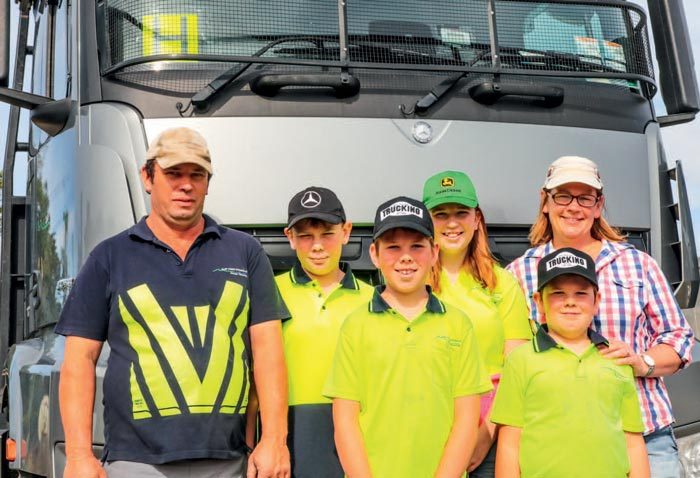
Photo: McGuinness family, generations two and three. (From left) Jay, Sam, Brodie, Alice, Fregus, and Bev.
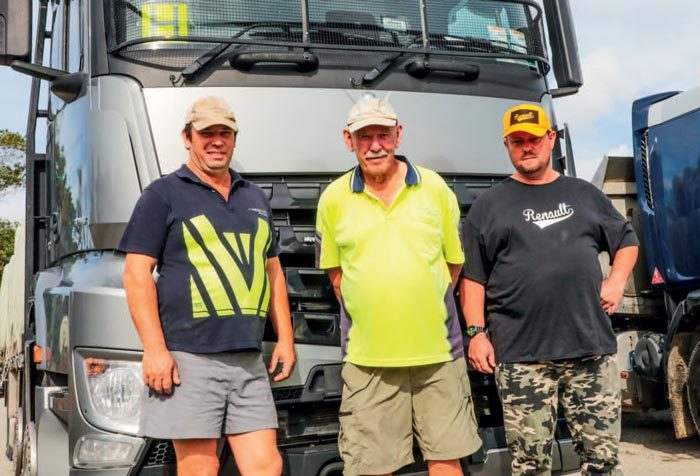
Photo: John McGuniness (Centre) with Jay to the left and Charles on the right.
Smitten
When Tom Twist‘s 3254 Actros appeared in Truck and Driver magazine in the mid- 2000s, Jay was smitten. “I said to Bev, ‘I‘m going to own that truck one day‘ and always kept an eye on where it was, waiting for the moment it was in my price bracket.” That moment occurred in 2012, and the big ex-Twist Benz arrived on the station. But let‘s back up for moment; there were a couple of significant events that happened in the intervening eight years that were integral to the arrival of bigger and better trucks. The great thing about life is you can‘t see beyond the horizon, and in 2006, just before the GFC, the McGuinnesses brought the 1000-hectare Caledonia station located to the north of Flat Point. The truth is, if you‘re a glass-half-full, hardworking family, things like that just end up an anecdote in a long, rich history. At that point, Flat Point reached the 3000 hectares it is today. You don‘t need to engage with sheep and beef farmers for too long before you hear them lament the sheep part of that famous farming duo. As a diversified operation, Flat Point always has multiple eggs in its basket across the agricultural sector, and a significant new egg turned up simply by chance in 2008. The farm grew lucerne baleage for its own needs. A hardy, super-high protein crop, lucerne is used as part of a managed-feed programme in many farming types. With both sheep and beef in a bit of slump at the time, Jay had spare stocks of the feed so advertised it in the paper. A dairy goat farm in Taranaki snapped it up. The rest as they say… . “It‘s just grown steadily since, and now we supply dairy goat operations in a number of areas, including that original customer in the ‘Naki‘, and others in the Waikato,” says Jay. “We grow it here on the farm, but also lease a bit of land in the Wairarapa, and do some contract growing also.

Photo: Jay is an absolute whiz when it comes to loading and unloading bales.
We just work it into the wider contracting operation.” Demand-driven A bigger farm, a growing feed-supply business, and a busy contracting operation; aside from the fact the boss was a truck and tractor buff, you can see how a fleetreplacement programme was essential. An ex-Barret Taura 3238, purchased some years earlier, was sold on the Twist Actros, which joined an ex-Hilton Haulage 3246 V6 Actros at the time of its arrival. “I replaced the V6 engine in that truck with a V8 after it dropped the harmonic balancer and died. It‘s a testament to the product that it did a full return trip north before dying. The bearing had scoured out the block, but the crank remained intact. “It‘s a bit of a bugger there‘s no more V8s. We put straight pipes on them,” says Jay. “Love that growl.” “I always knew when he was coming home because I could hear it coming up the other side of the hill,” says Bev. “Now, with the new one, I can‘t hear a thing.” In 2017, the V6-turned-V8 was pensioned off for an 8×4 ex-Bushetts Transport 3254 V8. Another straight-pipe V8 was in the McGuinness family. “They really looked the part together and sounded the part also,” says Jay with a grin. In the three years that they formed the front line, the two Actros brothers got through a power of work in eight-axle combination, as flat decks or set up with crates. Because the ex-Bushetts machine was fitted with hydraulics, it could also run as a drop sider, towing a 3-axle tipping trailer reserved for such duties. That capability meant it was the long-sought-after Twist truck that had to toot ‘bye bye‘ at the top of the hill for the last time a few months ago when the decision to buy the Arocs had been made. “It‘s the first truck we‘ve sold that everyone was sad to see leave. It was a bit sombre for a while, but you have to move on, and the new machine is bloody nice. Still miss the sound though.”
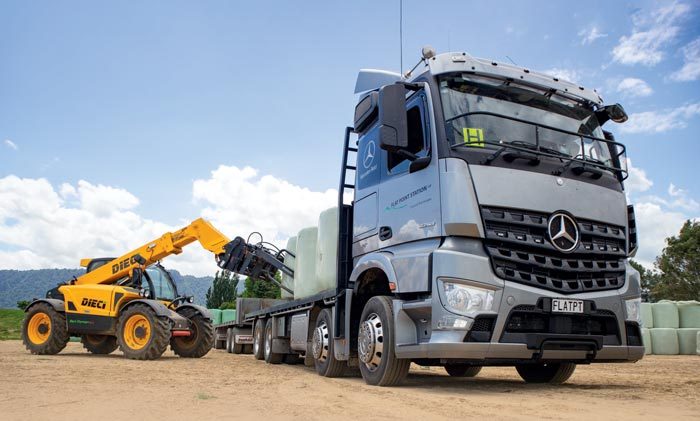
A day out with Jay
As all but the most entrenched city-dweller will know, farming is a seasonal occupation. That means catching the Flat Point trucks in all their various guises would take pretty much a year. For New Zealand Trucking, it was summer, and that means baleage. Although there‘s always something on the go, it‘s definitely one of those pressure moments in the year‘s calendar. The contracting arm was in full swing with bales on the ground in the Wairarapa to be uplifted, and plenty more grass and lucerne awaiting the baler‘s pick-up tynes. “It‘s a real toss-up this time of year. I have feed customers to service, but there‘s baling to be done, so everyone‘s spread pretty thin for a few weeks.” With the Arocs also came a trailer upgrade. Jay and Bev bought an ex-CourierPost 11.1m 5-axle curtain inside trailer, and Jay chopped the body off, making it a flatdeck. The plan is to tidy it up once the season is over and fit a brand-new headboard that matches the truck‘s. “I needed the deck space and tare weight so it won‘t be set up for crates,” says Jay. “It has the 4-axle stock trailer, and that‘s fine. D A McGovern Engineering in Masterton built the deck on the truck, and it‘s all fitted with effluent tanks, so it‘s just a case of putting the crate on the truck and swapping trailers. I can put 32 tonne on this at 50MAX. I may put it on 54 HPMV, but we‘ll wait and see.” Again, it‘s a careful calculation because so much of the rural work is scuppered by pesky bridges that aren‘t up to scratch. We met Jay at the beautiful Flat Point Station where he was loading lucerne bales to go to their yard on the outskirts of Masterton. “The Arocs actually spends most of its time operating ex-Masterton to all points. The Actros comes in and out most of the time. Being a tipper, it‘s more versatile on the inward leg.” The trucks have a low-key classy look in their two-tone iridescent grey and black. The Flat Point mountains and sea logo on the door adds subtle colour that catches the eye.
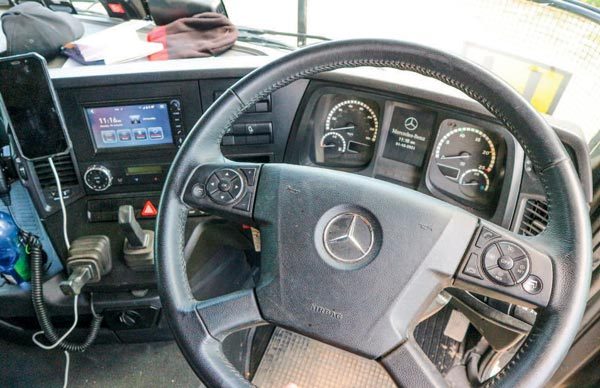 |
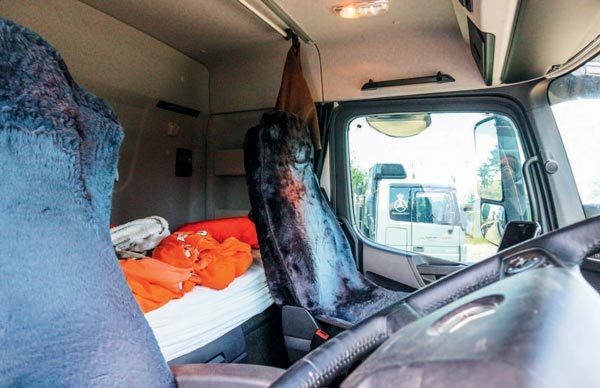 |
“Supreme Automotive in Masterton paints them. It also does Martinborough Transport, so that says it all really.” The road from the station itself is steep and gnarly gravel, and let‘s just say that the big tractors have come in handy over the years. Although it‘s called Flat Point Road, it‘s a council road, and there is an infrequent but regular flow of tourists, bach owners, and commercial fishing operators potentially coming toward you when dragging a full load out. The new truck powered up and out without issue. “I flick it into manual, no question. It‘s just too unpredictable. You have to finesse the throttle; left in auto, you can find yourself going nowhere in a second. It‘ll just walk out in third or fourth. “The engine brake is real good on this. I never buy second-hand trucks with retarders – they‘re just too expensive when they‘re old. I didn‘t even consider it on this. It‘s all steep and windy, so there‘s nothing to be gained really. Coming down the Kourarau hill, if you‘re in the right gear, it‘ll only need a couple of dabs on the brakes, and that‘s pretty bloody good.” Like all the Wairapapa Coastal destinations, coming out of Flat Point is like journeying from a tranquil world into some chaotic parallel universe that seems totally at odds from what you left an hour and a half earlier. Even if you‘re not from there, resisting the urge to turn and get back as quickly as you can takes some doing. In an instant, you completely understand the decision John McGuinness made in 1980. Beyond the farm gates, it‘s up, down, around, twist; gravel turns to bitumen, turns to gravel again. Then a dart to the left to avoid the lunatic in the Holden SUV driving in at psychotic speed on the most rural of gravel carriageways. A shake of the head, onward and out we go. With 40,000km on the clock since delivery, the Arocs has performed faultlessly. “Obviously, this one is getting service work at the agent. It was a Trucks and Trailers purchase but now falls under the Keith Andrews business. They‘re getting sorted in Palmy, and we have no complaints. Having done all the servicing and maintenance on the other trucks myself, I‘ve always just gone to Startech, the Mercedes-Benz parts people in Auckland. They‘re bloody great for sourcing parts. Once this is out of warranty, I‘ll just pick up the servicing. It has long-service intervals – 60,000km. That‘s way too long in this country, and she‘ll be getting a lookover more often than that.” The infamous Kourarau hill Jay mentioned looms large in front of the truck. It‘s either a steep pull heading out or a steep descent heading in. Ironically, once around the hideous 25kph corner at the foot, it‘s a largely straight pull (think slightly steeper than Ngauranga Gorge).
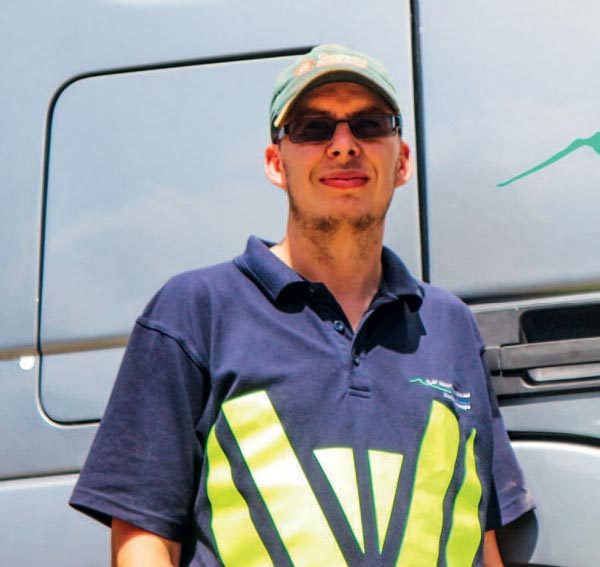 Photo: John Marr is full-time machine and truck driver on the station.
Photo: John Marr is full-time machine and truck driver on the station.
“It‘s caught a few out in its time,” says Jay. Having no run into it means you round the bottom corner and then simply slog. The Arocs motored up without fuss in 7th gear, and 25 to 30kph. “Only I‘ve driven this since it arrived. I can‘t get out of it,” he says with a grin. “I reckon it‘ll do about 80,000km to 100,000km per year. That‘s not bad for a farm truck is it?” The subject of fuel consumption gives an indication of just how hard the country is. “So far it‘s doing 1.8kpl, and that‘s about half a kilometre a litre better than V8s. They sat around 1.3 to 1.4kpl. The fuel and the lack of maintenance spend is pretty much covering the repayment difference on this.” Once unloaded, both Flat Point trucks headed to a contract cut near Martinborough for another load back to the yard. “See, I never go anywhere unannounced,” says truck driver John Marr as he passes by in the V8 Actros. The Arocs will never want for variation and will spend many an hour accessing narrow farm gates and races in the act of pulling baleage off a property, delivering it onto another, or moving store cattle on and off station. “We work in with local carriers. Martinborough Transport takes works sheep and cattle off the farm. Other stock cartage we handle ourself unless there‘s too much happening on the baleage front, it takes priority. We also use Burlings [Burling Transport] for taking feed north, especially this time of year when I‘m better off on the baler. I help with loads back down when I‘m able. We‘re a farm and cropping operation, and that‘s where our focus is, so often I just have to get back ASAP. At the end of the day it‘s all just the community of local businesses working in together.”
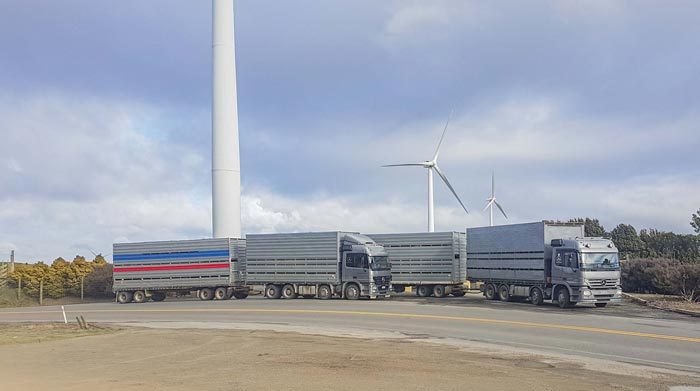
Photo: The 3254s moved a heap of product and stock in their day and made all the right noises doing it. This pic taken at the summit of the Saddle Road in the Manawatu.
Family before brand
What could be more glorious than watching an ace roam around a huge paddock loading 84 wrapped bales on two trucks and trailers in a flash? Jay was raised in such a remote and hands-on place, and to say he is a craftsman of the driving and machinery operating artform is an understatement. What takes him a couple of hours would take the average person double that, and some their entire life. We next saw Jay two days later delivering a load of lucerne to a dairy goat operation under the Kaimai ranges near Te Poi in the Waikato. “G‘day,” he appears around the corner of the truck. “I loaded this yesterday afternoon, and she‘s straight home now. There‘s a lot on. I‘ll be baling tomorrow.” The trucks more often than not carry their trailers home and he points out that there‘s an air tank to move on the new trailer‘s dolly to get that to happen. “I‘ll do that in the tidy-up once things have settled down.” Then the discussion turns to selfloading the flat-deck trailers, and we compare notes on what we‘ve individually thought of. I think at some point a self-load flat-deck trailer is inevitable. Jay McGuinness is ‘that‘ guy. He clarifies in your head why it was that a Kiwi was the first to climb to the top of a hill in Nepal in 1953. The signwriting on the Arocs door says ‘Flat Point Station, Wairarapa Coast‘, and there‘s that neat little graphic of the sea and mountains. Be it location or machine, most people will look and see a brand. But those who have been to Flat Point understand that this man and his family are writing their generation‘s chapter in a broader story of both an amazing location and legacy; and that this brand-new machine is way more than merely a cost centre, it‘ll be remembered as part of that story. It proves some stars are indeed lucky ones.

Photo: A picturesque sight on Wairarapa farmlands.





